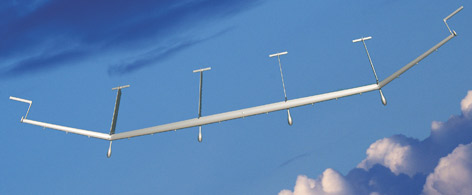Whether ferreting out insurgents in Afghanistan or monitoring agricultural trends in America, the ability to stay overhead and continue in a mission is of great importance for an aircraft providing aerial intelligence.
Our recent stories about 200-foot span, hybrid electric HALE (High Altitude Long Endurance) aircraft being tested at NASA Dryden Test Flight Center at Edwards Air Force Base showed a pair of large aircraft with the ability to stay up for a week, a persistence of overhead vision that is astonishing.
Now Boeing has announced a bigger, wildly more persistent vehicle, the SolarEagle, 435 feet in span, capable of floating around at 60,000 feet on solar/electric power for five years. The 6,000 pound airframe can carry a payload of 1,000 pounds, two-and-a-half times that of the Boeing PhantomEye or Aerovironment Global Observer currently being tested. With increasing miniaturization of electronics, such a craft could carry out multiple military and/or civilian missions simultaneously.
According to Defense Update, an online resource, Boeing and QinetiQ are teaming up to produce a vehicle for the US Defense Advanced Research Projects Agency’s (DARPA) Vulture program. Defense Update explains, “The objective of the Vulture program is to develop an aircraft capable of remaining on-station uninterrupted for over five years to perform intelligence, surveillance, reconnaissance (ISR), and communication missions over an area of interest. The technology challenges include development of energy management and reliability technologies capable of allowing the aircraft to operate continuously for five years. Vulture, in effect, will be a retaskable, persistent pseudo-satellite capability, in an aircraft package. The Vulture program will conclude with a year-long flight demonstration with a fully functional payload.” The vehicle would be able to provide 5 kilowatts of power continuously to power its sensor or communications packages and be able to maintain station for 99-percent of its mission. Such capabilities are otherwise only available at far greater costs through the use of geo-synchronous satellites.
Boeing and Qinetiq are using technology and lessons learned from the Zephyr program, described in earlier entries, to develop these capabilities. A smaller proof-of-concept prototype will take to the skies in 2013, and if that is successful, full-scale SolarEagle flights will begin in 2014.

